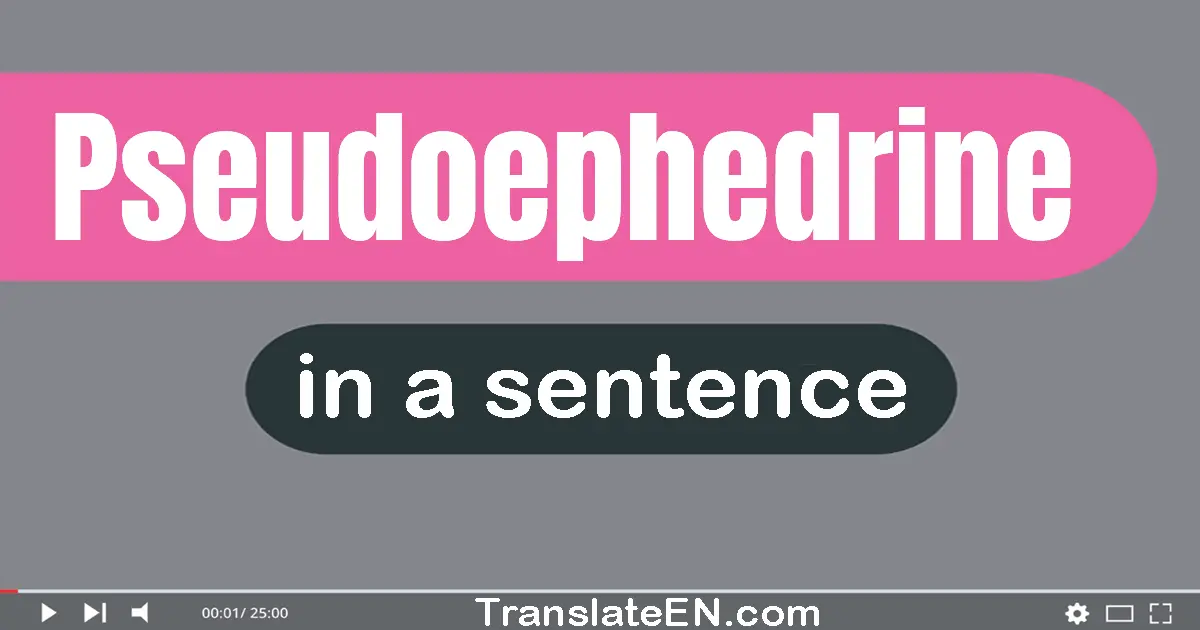Pseudoephedrine in a sentence
Synonym: decongestant, medication.
Meaning: A medication used to relieve nasal congestion.

(1) Pseudoephedrine can cause insomnia in some individuals.
(2) Pseudoephedrine can be found in both tablet and liquid forms.
(3) The active-ingredient in this decongestant is pseudoephedrine.
(4) Pseudoephedrine is available over-the-counter in many countries.
(5) Pseudoephedrine is available in both brand-name and generic forms.
(6) Pseudoephedrine can help relieve nasal congestion and sinus pressure.
(7) Pseudoephedrine may cause dizziness or drowsiness in some individuals.
(8) Pseudoephedrine is metabolized in the liver and excreted in the urine.
(9) Pseudoephedrine is a vasoconstrictor, meaning it narrows blood vessels.
(10) Pseudoephedrine is a common ingredient in combination cold and flu remedies.
Pseudoephedrine sentence
(11) Pseudoephedrine is sometimes used as a performance-enhancing drug in sports.
(12) It is important to follow the recommended dosage when taking pseudoephedrine.
(13) Pseudoephedrine should not be taken with alcohol or other sedating substances.
(14) Pseudoephedrine should be stored in a cool, dry place away from direct sunlight.
(15) Pseudoephedrine is not recommended for individuals with certain heart conditions.
(16) Pseudoephedrine is a sympathomimetic drug that acts on alpha-adrenergic receptors.
(17) Pseudoephedrine is commonly used as a decongestant in cold and allergy medications.
(18) Pseudoephedrine should be used as directed and not exceeded the recommended dosage.
(19) Pseudoephedrine is a controlled substance in some countries due to its potential for abuse.
(20) Pseudoephedrine is often used in combination with antihistamines to treat allergy symptoms.
Pseudoephedrine make sentence
(21) Pseudoephedrine is a common ingredient in many cold and flu remedies available at pharmacies.
(22) Pseudoephedrine is not recommended for pregnant or breastfeeding women without medical advice.
(23) Pseudoephedrine is not recommended for children under a certain age without medical supervision.
(24) The sale of pseudoephedrine is regulated due to its potential use in the production of methamphetamine.
(25) Pseudoephedrine should not be used for more than a few days without consulting a healthcare professional.
(26) Pseudoephedrine works by constricting blood vessels in the nasal passages, reducing swelling and congestion.
(27) Pseudoephedrine is sometimes used illegally as a stimulant due to its effects on the central nervous system.
(28) Some people may experience side effects such as increased heart rate or nervousness when taking pseudoephedrine.
(29) Pseudoephedrine is not recommended for individuals with certain medical conditions, such as high blood pressure.
(30) Pseudoephedrine can interact with other medications, so it is important to inform your healthcare provider of all the drugs you are taking.
Pseudoephedrine meaning
Pseudoephedrine is a commonly used medication that is primarily used as a decongestant to relieve nasal congestion caused by allergies, colds, or sinusitis. It is available over-the-counter in many countries, but due to its potential misuse in the production of illegal drugs, it is often regulated and sold behind the pharmacy counter. When it comes to using the word "pseudoephedrine" or the phrase "pseudoephedrine medication" in a sentence, it is important to ensure clarity and accuracy. Here are some tips on how to effectively incorporate this term into your writing:
1. Define the term: Begin by providing a brief definition or explanation of pseudoephedrine.
For example, "Pseudoephedrine is a sympathomimetic drug commonly used as a decongestant to alleviate nasal congestion."
2. Contextualize its use: To make your sentence more meaningful, provide context or background information about why pseudoephedrine is being mentioned. For instance, "The doctor prescribed a pseudoephedrine medication to relieve my severe sinus congestion."
3. Be specific: If you are referring to a particular brand or formulation of pseudoephedrine, mention it in your sentence.
For example, "I purchased a box of Sudafed, a popular pseudoephedrine medication, to alleviate my allergy symptoms."
4. Highlight its purpose: Emphasize the intended use or benefits of pseudoephedrine in your sentence. For instance, "Pseudoephedrine is highly effective in reducing nasal congestion, allowing individuals to breathe more easily."
5. Mention dosage or administration: If relevant, include information about the recommended dosage or administration of pseudoephedrine.
For example, "The pharmacist advised taking one tablet of pseudoephedrine every six hours to manage my congestion."
6. Discuss potential side effects or precautions: It is important to acknowledge the potential risks or precautions associated with pseudoephedrine use. For instance, "Although pseudoephedrine is generally safe, it may cause side effects such as increased heart rate or elevated blood pressure."
7. Highlight legal restrictions: If pseudoephedrine is regulated in your country, mention any legal restrictions or requirements associated with its purchase or use.
For example, "In the United States, pseudoephedrine is sold behind the pharmacy counter and requires identification and a signature due to its potential misuse in illegal drug production."
8. Provide alternatives or related terms: If you want to expand your sentence or provide additional information, you can mention alternative decongestants or related terms. For instance, "Other over-the-counter decongestants, such as phenylephrine, can be used as an alternative to pseudoephedrine." Remember to use proper grammar and sentence structure when incorporating the word "pseudoephedrine" or the phrase "pseudoephedrine medication" into your writing. By following these tips, you can effectively communicate the purpose, usage, and potential considerations associated with this medication.
The word usage examples above have been gathered from various sources to reflect current and historical usage of the word Pseudoephedrine. They do not represent the opinions of TranslateEN.com.
